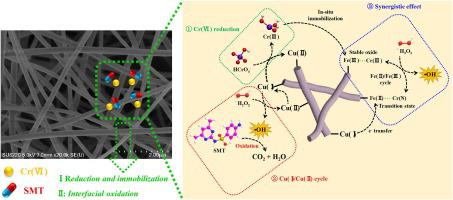Chemical Engineering Journal ( IF 13.3 ) Pub Date : 2023-07-27 , DOI: 10.1016/j.cej.2023.144984 Qian Yang , Yufei Zhong , Zhuqin Zhang , Zhi Dang , Fangbai Li , Lijuan Zhang

|
The co-existence of sulfamethazine (SMT) and heavy metal Cr(VI) may alter their migration and conversion laws and even their biological toxicity owing to their different physicochemical properties, greatly aggravating their environmental risks and elevating the difficulty of remediation. Herein, a novel flexible self-supporting Fe-Cu-Al2O3 nanofibrous membrane (1Fe-2Cu-Al2O3-800) was synthesized via a sol–gel method with the combination of electrospinning serving as a heterogeneous catalyst for simultaneous SMT degradation and Cr(VI) removal. Copper and iron elements were highly dispersed in the alumina nanofibrous matrix in the form of Fe(III), Cu(I), and Cu(II) species. There exists a wide applicable range of environmental pH for the 1Fe-2Cu-Al2O3-800/H2O2 system, exhibiting excellent catalytic selectivity and recycling performance. The surfaced-bound hydroxyl radicals activated by reductive Cu(I) species were the main active species of SMT degradation. Meanwhile, anionic Cr(VI) was rapidly adsorbed on 1Fe-2Cu-Al2O3-800 through electrostatic interaction, and then directly reduced to Cr(III) by adjacent reductive ≡Cu(I) species and subsequently incorporated into iron oxide to constitute a stable Fe-Cr(III) complex. Moreover, the degradation kinetics results showed that Fe(II)/Fe(III) cycle in the 1Fe-2Cu-Al2O3-800/H2O2 system could mediate Cr(III)/Cr(VI) cycle to prominently accelerate the SMT degradation through Haber-Weiss-type reaction, thereby having a synergistic effect. Overall, this work would provide new insights and a feasible strategy for the remediation of organic–inorganic composite pollutions, including SMT and Cr(VI).
中文翻译:

柔性自支撑 Fe-Cu-Al2O3 纳米纤维膜作为多相催化剂同时降解磺胺二甲嘧啶和还原 Cr(VI):深入了解协同效应和机制
磺胺二甲嘧啶(SMT)与重金属Cr(VI)共存,由于理化性质不同,可能会改变其迁移转化规律,甚至改变其生物毒性,大大加剧其环境风险,增加修复难度。在此,通过合成一种新型柔性自支撑Fe-Cu-Al 2 O 3纳米纤维膜(1Fe-2Cu-Al 2 O 3 -800)溶胶-凝胶法与静电纺丝相结合,作为多相催化剂,同时进行 SMT 降解和 Cr(VI) 去除。铜和铁元素以 Fe(III)、Cu(I) 和 Cu(II) 形式高度分散在氧化铝纳米纤维基质中。1Fe-2Cu-Al 2 O 3 -800/H 2 O 2体系具有较宽的环境pH适用范围,表现出优异的催化选择性和回收性能。还原性Cu(I)物种激活的表面结合羟基自由基是SMT降解的主要活性物种。同时,阴离子Cr(VI)被快速吸附在1Fe-2Cu-Al 2 O 3上-800通过静电相互作用,然后被相邻的还原性 ≡Cu(I) 物质直接还原为 Cr(III),随后与氧化铁结合形成稳定的 Fe-Cr(III) 络合物。此外,降解动力学结果表明,1Fe-2Cu-Al 2 O 3 -800/H 2 O 2体系中的Fe(II)/Fe(III)循环可以显着介导Cr(III)/Cr(VI)循环。通过Haber-Weiss型反应加速SMT降解,从而产生协同效应。总体而言,这项工作将为修复有机-无机复合污染(包括 SMT 和 Cr(VI))提供新的见解和可行的策略。































 京公网安备 11010802027423号
京公网安备 11010802027423号